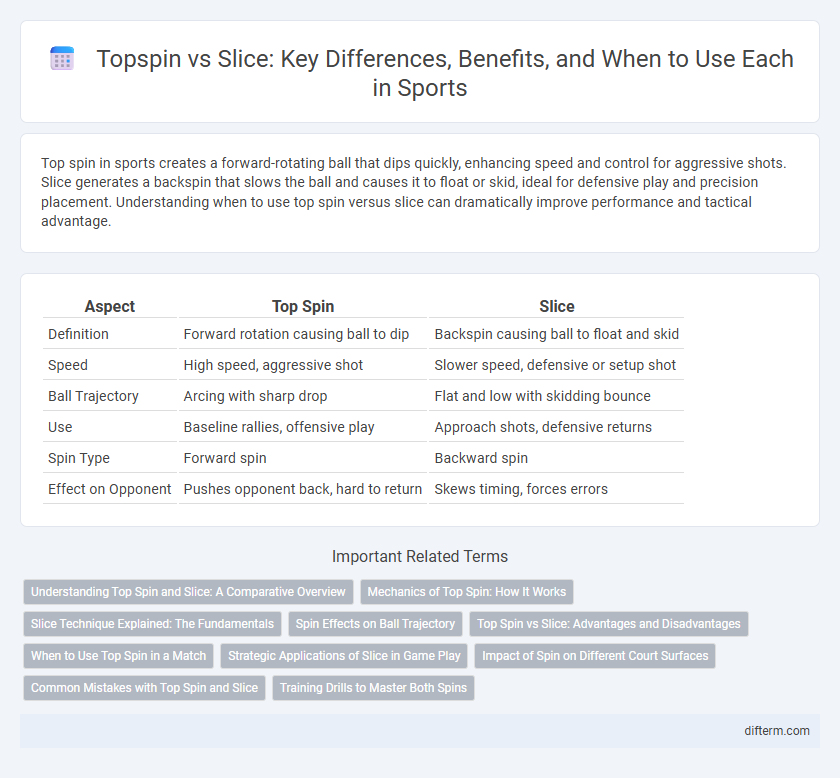Top spin in sports creates a forward-rotating ball that dips quickly, enhancing speed and control for aggressive shots. Slice generates a backspin that slows the ball and causes it to float or skid, ideal for defensive play and precision placement. Understanding when to use top spin versus slice can dramatically improve performance and tactical advantage.
Table of Comparison
| Aspect | Top Spin | Slice |
|---|---|---|
| Definition | Forward rotation causing ball to dip | Backspin causing ball to float and skid |
| Speed | High speed, aggressive shot | Slower speed, defensive or setup shot |
| Ball Trajectory | Arcing with sharp drop | Flat and low with skidding bounce |
| Use | Baseline rallies, offensive play | Approach shots, defensive returns |
| Spin Type | Forward spin | Backward spin |
| Effect on Opponent | Pushes opponent back, hard to return | Skews timing, forces errors |
Understanding Top Spin and Slice: A Comparative Overview
Top spin generates forward rotation on the ball, creating a dip and bounce that enhances control and speed, ideal for aggressive baseline play. Slice produces backspin, causing the ball to float and skid low, useful for disrupting opponents' rhythm and executing defensive shots. Understanding the distinct spin effects allows players to strategically vary shot trajectories and improve overall game versatility.
Mechanics of Top Spin: How It Works
Top spin in sports leverages the rapid forward rotation of the ball, created by brushing the racket upward and forward at contact, generating increased Magnus effect for enhanced control and bounce. This forward spin stabilizes the ball's flight path, allowing for deeper, faster shots that dip sharply after clearing the net. The mechanics contrast with slice, which induces backspin, slowing the ball and causing it to skid low upon bouncing, emphasizing top spin's advantage in power and aggression in rallies.
Slice Technique Explained: The Fundamentals
Slice technique in sports like tennis involves hitting the ball with a slightly open racquet face to create backspin, causing the ball to move slower and with a low bouncing trajectory. This backspin effect helps in disrupting the opponent's rhythm and making the ball skid off the surface, providing greater control and precision. Mastering the slice requires proper grip, a controlled swing path, and precise wrist action to generate effective spin and maintain consistent shot placement.
Spin Effects on Ball Trajectory
Topspin generates a forward rotation on the ball, causing it to dip sharply and bounce higher, which pressures opponents with faster ball trajectories and enhanced control. In contrast, slice imparts backspin, leading to slower ball speed, a flatter trajectory, and lower, skidding bounces that disrupt timing. Understanding these spin effects on ball trajectory is crucial for optimizing shot selection and strategy in tennis and other racket sports.
Top Spin vs Slice: Advantages and Disadvantages
Top spin generates a higher bounce and greater ball control, making it ideal for aggressive baseline play and pushing opponents back, while slice produces a low, skidding trajectory that disrupts rhythm and slows the ball, forcing errors. Top spin's advantage lies in its ability to increase margin for error and maintain offensive pressure, but it can be physically demanding and less effective on fast surfaces. Slice offers precision and tactical variety, especially useful for defense and approach shots, yet it sacrifices power and can be easier to attack.
When to Use Top Spin in a Match
Top spin is most effective during baseline rallies to generate heavy forward rotation, increasing ball control and enabling aggressive shot placement. It creates a higher bounce, pushing opponents back and opening the court for offensive plays. Using top spin strategically can dominate points by forcing errors or weak returns from adversaries.
Strategic Applications of Slice in Game Play
Slice shots in tennis strategically disrupt opponents by varying ball speed and trajectory, forcing errors and defensive positioning. Executing a well-timed slice can neutralize aggressive baseline rallies and create opportunities for approach shots. Players leverage slice to control pace, extend rallies, and exploit opponents' weaknesses on low ball returns.
Impact of Spin on Different Court Surfaces
Topspin generates high bounce and grip on clay courts, enhancing control and shot margin, while slice shots stay lower and skid, making them more effective on fast grass courts. Hard courts provide a balanced environment where topspin accelerates ball speed and slice disrupts rhythm with low, skidding trajectories. Understanding these spin dynamics helps players optimize performance by selecting shots tailored to the unique friction and bounce characteristics of each surface.
Common Mistakes with Top Spin and Slice
Common mistakes with topspin include overhitting the ball, which results in loss of control and inconsistency, and improper racket angle that prevents generating the desired topspin effect. In slice shots, players often fail to maintain a sharp downward racket motion, leading to a flat or weak slice that lacks effective backspin and trajectory control. Both errors reduce shot effectiveness, highlighting the importance of mastering technique and racket positioning in tennis or other racquet sports.
Training Drills to Master Both Spins
Training drills to master both topspin and slice emphasize repetitive stroke practice with focused ball contact points and wrist action. Incorporating multi-ball drills that alternate between topspin and slice shots enhances muscle memory and control under varying speeds and spins. Using video analysis during practice sessions helps refine technique by providing visual feedback on racket angle and swing path, crucial for effective spin execution.
top spin vs slice Infographic

 difterm.com
difterm.com